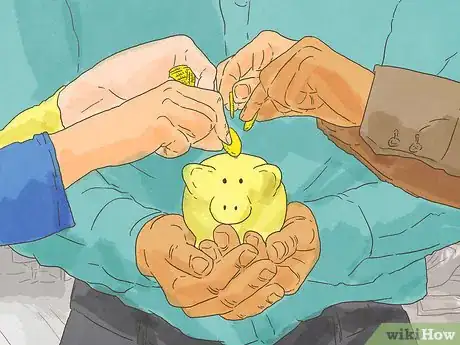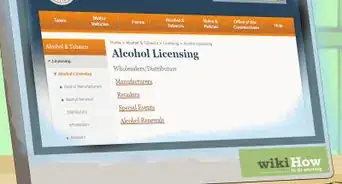This article was co-authored by wikiHow Staff. Our trained team of editors and researchers validate articles for accuracy and comprehensiveness. wikiHow's Content Management Team carefully monitors the work from our editorial staff to ensure that each article is backed by trusted research and meets our high quality standards.
There are 14 references cited in this article, which can be found at the bottom of the page.
This article has been viewed 33,594 times.
Learn more...
If you’ve always dreamed of running your own distillery, there’s never been a better time. The popularity of craft liquors is on the rise, and getting a foothold in the industry is no longer an unattainable fantasy. It’s critical to know, however, how to go about starting your distillery the right way to ensure that you can follow your passion and earn a living while avoiding common pitfalls. Once you’ve taken the first step of securing funding, you can apply for a distiller’s license, purchase equipment and supplies and begin carving out a place for your unique personal brand.
Steps
Preparing to Open a Distillery
-
1Be ready to devote yourself to your craft. Owning any business is a extraordinary commitment. To make it as an entrepreneur, you must be willing to work seven days out of the week. This will often involve long, sleepless nights of coming up with new ideas and working out solutions to problems that spring up along the way. Before you take on the challenge, be sure that you have the determination to stick with it.[1]
- Your new distillery won’t be making any money in its infancy. Unless you have a benefactor or receive a sizable business loan, you’ll likely have to juggle the responsibilities of devising a business strategy while working other jobs to pay the rent.
- Speak to other entrepreneurs who have opened their own distilleries and ask if they have any helpful advice to share with you.
-
2File for a distiller’s permit. There’s a lot of legal regulation surrounding breweries, distilleries and other businesses that manufacture and sell alcohol. First, you’ll have to obtain a distiller’s permit from the appropriate government agency. Following that, you’ll need to be approved for a liquor license and other applicable permits at the state or local level. Without the proper paperwork, you won’t be able to move forward with opening your distillery.[2]
- Those living in the United States can visit the website of the Alcohol and Tobacco Tax and Trade Bureau to complete the application process for a distiller's permit, as well as request additional information and materials.[3]
- The legal processes involved with starting a distillery are straightforward, but can be time-consuming. It’s best to get started as soon as you’ve made up your mind to pursue your goal.[4]
Advertisement -
3Research your product extensively. To be the best you can possibly be at what you do, you’ll need to become a walking encyclopedia of liquor-related knowledge. Sample as many liquors as you can, visit other distilleries and keep your eyes and ears open for new developments in the industry. Always be looking to expand your knowledge on both the practical and business end of things.
- Get in the habit of trying new brands and brews regularly. You should have a wealth of firsthand experience to be able to articulate the differences between your product and others.
- Attend distillery festivals and special events whenever possible. These types of events usually feature an enormous selection of craft spirits, and can provide a great hands-on learning opportunity.
-
4Think about what you’re going to add to the market. What can you do to make your distillery stand out among your competitors? You might plan on employing an inventive hybrid distilling method or incorporating never-before-seen ingredients into the mix. Or perhaps you’re determined to introduce people who don’t drink gin to the beverage in an enjoyable way. Whatever your approach may be, you should aim to proceed with a clear purpose in mind.[5]
- If you’re unable to come up with a clear answer to this question, you’ll likely have a harder time turning your brand into something truly special.
- While trying other liquors, make a list of what works, what’s missing and what could be done better. Direct comparison will put you on the right track to crafting a beverage that hits all the right notes.[6]
Launching Your Business
-
1Find a way to get funding. Opening a distillery involves applying for a business license, leasing a suitable property, buying a lot of expensive equipment, and hiring help. To be able to meet these demands, you’ll need to appeal to outside investors for capital. In most cases, you’ll need to be able to come up with $350,000—500,000 to make a brand new distillery work.[7]
- For most upstarts, pitching your business to a committee of private investors is the simplest way to go. One major advantage of this method is that you’ll have far more money up front to work with. The downside, however, is that you’ll have to give up partial control over the decisions and direction of your company to the investors, who will then own a share.
- As an alternative, consider boosting your finances via crowdsourcing. Through resources like Indiegogo, Kickstarter or EquityNet, you may be able to collect enough money in personal donations to pay for the basic necessities. Furthermore, popular funding will allow you to retain full ownership of the business.[8]
-
2Seek help from other interested parties. It may be that you have friends, relatives or other associates who might be eager to get involved in this business undertaking with you. Surround yourself with like-minded people who share your passion and want to see your vision become a reality. Having a team you can trust is invaluable asset in building a business from the ground up.[9]
- Give close associates the chance to become co-investors and have an equal say in shaping the business.
-
3Secure a location. Shop around for a physical headquarters for your distillery. Some possible options include small, freestanding workshops, warehouse buildings or spacious storefronts. Make sure that your projected startup budget will allow you to pay the lease on your property and have enough leftover to carry out your distilling operations comfortably.
- Map out a radius where you’d prefer to set up your distillery and explore the vicinity to check out what’s available.
- Enlist the aid of a commercial realtor. These agents will familiarize you with the properties listed in your area, and can often alert you to locations that you otherwise would have never come across.[10]
-
4Hire employees. Sooner or later, you're going to need a few extra sets of hands. Working with a dedicated team will help you stick to a busy production schedule and give you a much needed break from handling every aspect of the business yourself. In the beginning, your staff will probably be fairly small. As your distillery grows in size and renown, you can think about adding brewmasters, bottlers, delivery drivers, marketing specialists and other employees to your team.
- Conduct in-person interviews to get a sense of your prospective employee's relevant qualifications, experience and enthusiasm for your brand.[11]
- Make sure you budget properly so that you'll be able to pay your staff fairly without eating into your profits.
-
5Offer an original concept. No one will take notice of your brand if you’re putting out the same sort of product that everyone else is. Draw from diverse distilling traditions or experiment with using unorthodox ingredients in your brews. Ultimately, your distillery’s popularity might even come down to its unique packaging and labeling, which will attract the attention of first-time tasters.
- Think back on your plans for how to add something new to the market and use them as inspiration to generate specific product and marketing ideas.
- For example, a niche market may exist for people who ordinarily prefer cocktails. By infusing your liquors with sweet, fruity or zesty flavors, you stand to reach a larger consumer base.[12]
Running a Successful Distillery
-
1Purchase stills and other distilling equipment. What’s a distillery without stills? These are these first thing you’ll need to procure before you can get your distillery up and running. Decide whether it would be better to run with one or two small stills or invest in a large one that can handle a high rate of output. Along with a trustworthy still, you’ll require additional equipment like a boiler, mash tun and storage tanks, just to name a few.[13]
- Good stills are not cheap. Top-of-the-line varieties often go for between $50,000—250,000, which will constitute a big portion of your startup money.[14]
- Look into whether it’s possible to get some of your equipment secondhand. Be sure to verify that everything is in good working order before you commit to buying, though.[15]
-
2Plot out the practical details of your operations. Running a distillery isn't as simple as just churning out liquor. It will be important to think over the little considerations, as well, such as where your water will be coming from, how often supply orders should be placed to maintain productivity and what if any services will need to be subcontracted. These might not seem like major concerns, but the way you go about handling them can make or break a young business.[16]
- It may also be necessary to meet with your city's alcoholic beverage commission to get a rundown on the most up-to-date liquor laws.[17]
- Don't be discouraged if it all seems a little overwhelming at first. In many ways, learning the ins and outs of owning a business is a work in progress. Each time you face a difficult task or unexpected obstacle, you'll be better equipped to deal with it in the future.
-
3Find a source for your distilling ingredients. Before you can jump right into the brewing process, you’ll need to contract with a supplier who can provide you with the various things you’ll need to brew your signature liquors. This will include things like yeast, grains, fruits, spices and raw alcohol spirits. Take your time selecting high-quality ingredients that are consistent with your distilling philosophy.[18]
- Take advantage of local co-ops and markets that grow organic grains and produce. Liquors sourced with local ingredients are a big hit with alcohol enthusiasts and may prove to be a beneficial selling point.[19]
- Give your proprietary recipes a test run with friends, family and other connoisseurs before putting them into production.[20]
-
4Start by making non-aged liquors. While specialty aged liquors are the most sought-after, they unfortunately take months or years to take on their potent, complex flavors. If you’re planning on distilling fine aged liquors, focus on cranking out “white” spirits in the early stages, such as vodka, gin or white whiskey, as these don’t require as much fermentation. This is a good way to get your product into people’s hands and make enough profit to keep the business afloat while your more refined batches have a chance to properly season.[21]
- Darker liquors like scotch, rum and brandy are aged in wooden barrels, which is where they get their deep color and flavor.[22]
- Offering a range of liquors is typically no more costly, and can potentially increase your profit margin by appealing to many different tastes.
-
5Work hard and be patient. It’s unlikely that your distillery will become a commercial success overnight. It may take years or even decades to establish a reputation that will put you on the map. If you’re truly passionate about what you’re doing, though, don’t give up. As your practical skills and understanding of the many facets of distilling liquors grow, so will your business.
- Expect to put in the most work during the first few months while you’re still getting off the ground.
Warnings
- Take particular care to complete your application paperwork thoroughly and accurately. If some part of the process is deemed unsatisfactory, you may be denied the permits you need or even face legal repercussions.⧼thumbs_response⧽
- Don't put all your eggs in one basket. Save or invest as much extra money as you can in case your distillery business doesn't pan out.⧼thumbs_response⧽
References
- ↑ https://spiritsbeacon.com/guides/how-tos/how-to-open-a-distillery
- ↑ https://www.linkedin.com/pulse/7-things-know-before-starting-micro-distillery-konstantin-parkhomenko
- ↑ https://www.ttb.gov/spirits/spirits-permits.shtml
- ↑ http://www.slate.com/blogs/moneybox/2014/09/04/federal_state_and_local_regulations_make_opening_a_craft_distillery_a_long.html
- ↑ http://beverage-master.com/article/starting-a-new-craft-distillery-part-3/
- ↑ https://spiritsbeacon.com/guides/how-tos/how-to-open-a-distillery
- ↑ https://spiritsbeacon.com/guides/how-tos/how-to-open-a-distillery
- ↑ https://www.entrepreneur.com/article/228534
- ↑ https://www.entrepreneur.com/article/246097
- ↑ http://www.nolo.com/legal-encyclopedia/clb-how-commercial-real-estate-brokers-work.html
- ↑ http://www.bizbrain.org/intro-guide-to-interviewing-prospective-employees/
- ↑ https://www.entrepreneur.com/article/246097
- ↑ http://www.equippedbrewer.com/equipment-and-supplies/how-to-choose-the-right-distillery-equipment
- ↑ https://spiritsbeacon.com/guides/how-tos/how-to-open-a-distillery
- ↑ http://www.telegraph.co.uk/men/the-filter/11329984/How-easy-is-it-to-start-your-own-microbrewery.html
- ↑ http://beverage-master.com/article/starting-a-new-craft-distillery-part-2/
- ↑ http://www.slate.com/blogs/moneybox/2014/09/04/federal_state_and_local_regulations_make_opening_a_craft_distillery_a_long.html
- ↑ https://spiritsbeacon.com/guides/how-tos/how-to-open-a-distillery
- ↑ https://www.clawhammersupply.com/blogs/moonshine-still-blog/114605060-distilling-with-local-ingredients
- ↑ https://spiritsbeacon.com/guides/how-tos/how-to-open-a-distillery
- ↑ https://www.entrepreneur.com/article/246097
- ↑ https://www.leslabs.com/blog/brown-or-white-which-liquor-is-right








































































